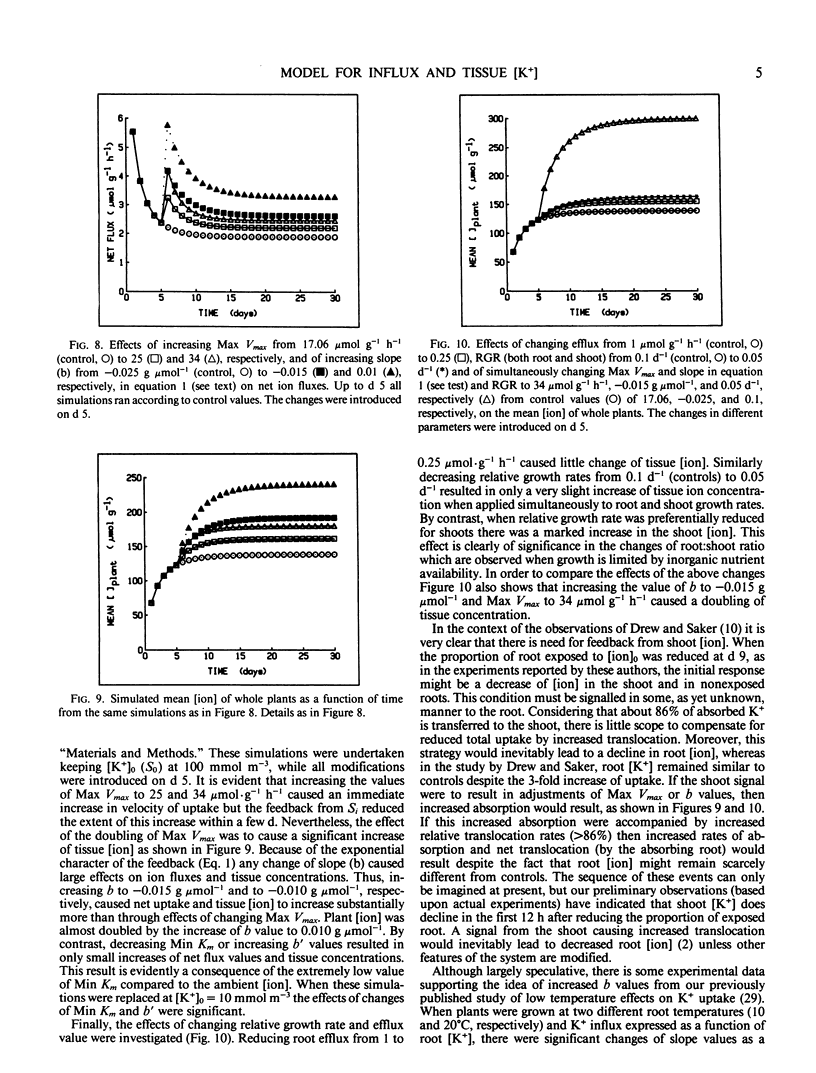Abstract
By means of a modified Michaelis-Menten equation for K+ influx, which includes terms for root and external K+ concentrations (root [K+] and [K+]0, respectively) it is possible to predict the manner in which short-term (perturbation) fluxes of K+ into roots of barley plants (Hordeum vulgare cv Fergus) vary with root [K+] and [K+]0. Influx values derived from this equation were used to predict changes of root and shoot [K+] and K+ absorption rates (as functions of time and [K+]0) from a knowledge of K+ efflux, relative growth rates of roots and shoots, and the partitioning of absorbed K+ between these organs. A microcomputer program was employed to model these changes in low-salt plants following transfer to solutions in which [K+]0 was maintained at values ranging from 5 to 1000 millimoles per cubic meter. The model was operated on the basis of 10 minute absorption periods which provided data for continuous `updating' of tissue [K+]. The simulations were undertaken for periods corresponding to 30 days. During this time the model accurately predicted the manner in which K+ influx and root and shoot [K+] gradually approach values which are essentially independent of [K+]0. The computer program was also used to predict the outcome of changing various external and internal parameters of the proposed regulatory system. The results of these simulations are discussed in the context of current models for negative feedback control of ion fluxes.
Full text
PDF






Selected References
These references are in PubMed. This may not be the complete list of references from this article.
- Glass A. D. Regulation of potassium absorption in barley roots: an allosteric model. Plant Physiol. 1976 Jul;58(1):33–37. doi: 10.1104/pp.58.1.33. [DOI] [PMC free article] [PubMed] [Google Scholar]
- Pitman M. G., Cram W. J. Regulation of ion content in whole plants. Symp Soc Exp Biol. 1977;31:391–424. [PubMed] [Google Scholar]
- Sanders D. Physiological Control of Chloride Transport in Chara corallina: I. EFFECTS OF LOW TEMPERATURE, CELL TURGOR PRESSURE, AND ANIONS. Plant Physiol. 1981 Jun;67(6):1113–1118. doi: 10.1104/pp.67.6.1113. [DOI] [PMC free article] [PubMed] [Google Scholar]
- Siddiqi M. Y., Glass A. D. Simultaneous consideration of tissue and substrate potassium concentration in k uptake kinetics: a model. Plant Physiol. 1982 Jan;69(1):283–285. doi: 10.1104/pp.69.1.283. [DOI] [PMC free article] [PubMed] [Google Scholar]
- Siddiqi M. Y., Memon A. R., Glass A. D. Regulation of k influx in barley : effects of low temperature. Plant Physiol. 1984 Mar;74(3):730–734. doi: 10.1104/pp.74.3.730. [DOI] [PMC free article] [PubMed] [Google Scholar]


